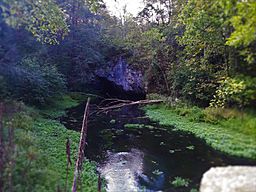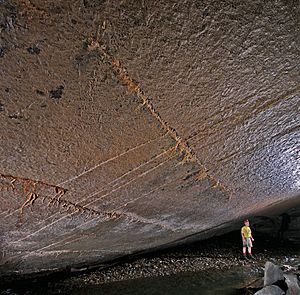Tytoona Cave facts for kids
Tytoona Cave is a cool natural cave located in Sinking Valley, Pennsylvania. It's about 1-mile (1.6 km) from Arch Springs. You can find it near the towns of Tyrone and Altoona in the United States. This cave has a long and interesting story!
Exploring Tytoona Cave's Past
How Tytoona Cave Got Its Name
Tytoona Cave has had a few different names over the years. People used to call it Sinking Valley Cave or Arch Spring Cave. Its history goes way back to the 1750s. That's when the first European settlers arrived in the Sinking Valley area.
Old Stories About the Cave
There are some old stories about the cave from a long time ago. One story says that around 1750, some local rangers were chasing Native Americans into the cave. The Native Americans had been involved in a conflict with settlers. The story claims they never came out of the main entrance where the rangers waited. People wondered if they died inside or found another secret way out. Since no other way in or out has ever been found, it's more likely the rangers didn't wait long enough. They might have been too scared to go inside themselves.
First Descriptions of the Cave
The first written description of the Sinking Valley area came out in 1788. It was in a magazine called the Columbian Magazine. William Spotswood wrote about the history of Sinking Valley and a nearby fort. He also mentioned the end of the Tytoona cave system at Arch Spring. He described how water flowed out from "a rude arch of stone." He also gave the first known description of the cave's entrance. He said the opening continued for about 400 yards. Then, after a turn, it opened into a "spacious room." At the bottom of this room was a "vortex" where water spun around with great force.
Attempts to Open the Cave to Visitors
People tried to turn Tytoona Cave into a tourist attraction twice. One attempt was in 1947 and another in 1972. Neither of these plans lasted very long. Today, you can barely see any signs of them. The 1972 attempt failed because of a huge flood. Hurricane Agnes caused floods all over the region. Tytoona Cave, which was called Indian River Caverns at the time, filled completely with water. All the steps, railings, and pathways that had been built were washed away. The remains of these old structures now form a large pile of logs inside the cave. This logjam is about 122 meters (400 feet) into the cave.
A Sad Event in the Cave's History
On June 20, 1988, a sad accident happened in the cave. Two cave divers, John Schweyen and Roberta Swicegood, were exploring and mapping the cave. They were starting from the Arch Spring end. They found two deep underwater sections called sumps. The second sump was very long and deep. It was about 305 meters (1000 feet) long and 32 meters (105 feet) deep underwater. After John left the cave, Roberta went back in for another dive by herself. When she didn't come back, other divers tried to find her. Sadly, they were not successful. Her body was found four days later. It seems she lost her guide rope in the second sump. With almost no visibility underwater, she couldn't find her way back before her air ran out. Because of this tragedy, the owners of the cave stopped all cave diving there for a long time. Today, cave diving is still not allowed at Tytoona Cave. You need special written permission from the Tytoona Cave Preserve management to dive there.
What Tytoona Cave Looks Like Inside
The Entrance and Flowing Water
The entrance to Tytoona Cave is in a deep hole in the ground called a sinkhole. This sinkhole is about 100-foot (30 m) deep. A stream of water comes out from the bottom of a steep wall in the sinkhole. This stream flows for about 100 feet before entering the cave. Another stream, called Sinking Run, also flows into the sinkhole from above ground. It joins the stream coming from the cliff. The amount of water in these streams changes a lot. It depends on how much rain has fallen recently. The cave entrance itself slopes down from the left side. It reaches a high point of about 12 feet on the right.
Inside the Main Passage
Inside the cave, the stream bed is mostly flat and quite wide, about 25 feet across. The bottom of the stream is covered with gravel. On the left side of the cave, there's a path made of clay over a rock shelf. There are also a few very short passages that don't go anywhere.
Exploring Deeper into the Cave
The first few hundred feet of Tytoona Cave are easy for almost anyone to explore. However, about 400 feet inside, there's a huge pile of logs that almost completely blocks the way. Up to this point, you won't see many cave formations. These are things like flowstone, stalagmites, stalactites, or soda straws. But if you know the cave well, you can get past the logjam. You can walk through the stream, which flows under most of the logs.
Past the logjam, there's another passage about 500 feet long. In this section, you can see more cave formations. Sadly, some of them have been damaged over time. You might also spot some old wooden beams. These are leftover pieces from when people tried to make the cave a tourist attraction. You can walk for about 900 feet in total before you reach an underwater section called a sump.
Beyond the Sumps
Past this first sump, there are more rooms connected by other sumps. The first of these rooms has amazing formations. It's also airtight, meaning it never fills with water, no matter how high the stream gets. However, as mentioned before, the current owners of the cave do not allow cave diving. Even if diving were allowed, it would be very hard to get past the first sump. There's a lot of debris, and you can barely see anything underwater.
Eventually, the stream inside Tytoona Cave connects with the nearby Arch Spring Cave. But you can't travel all the way through because of underwater blockages and cave-ins. The total length of the entire cave system, from the entrance to its exit at Arch Spring, is about 4,200-foot (1,300 m).



